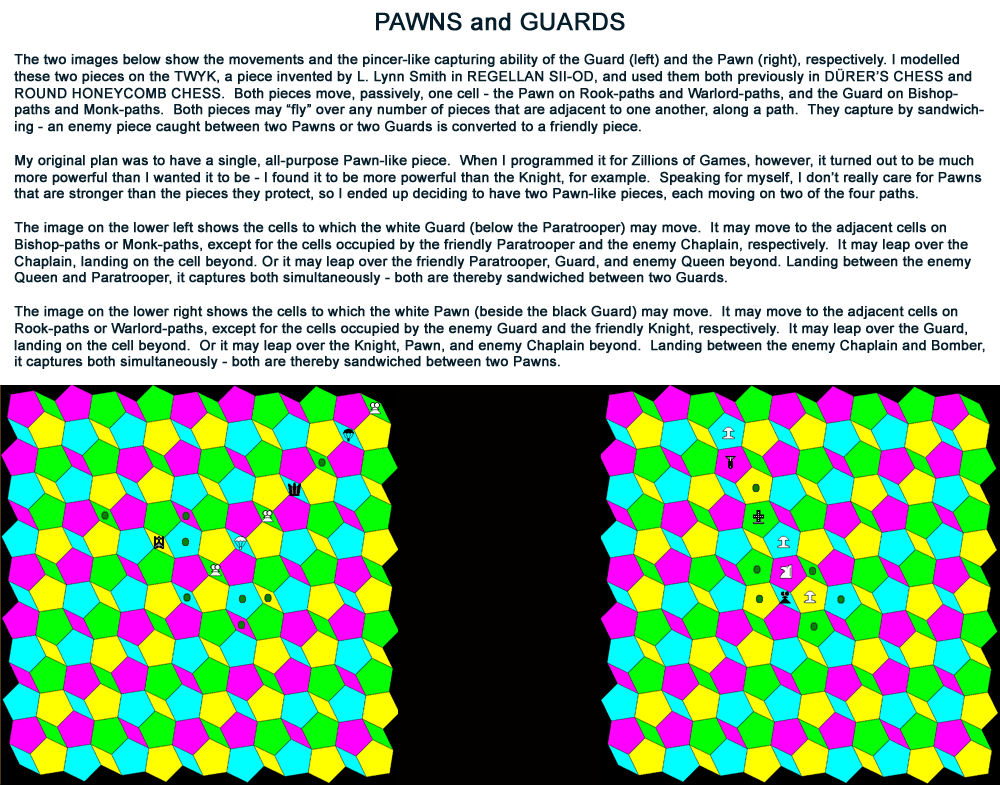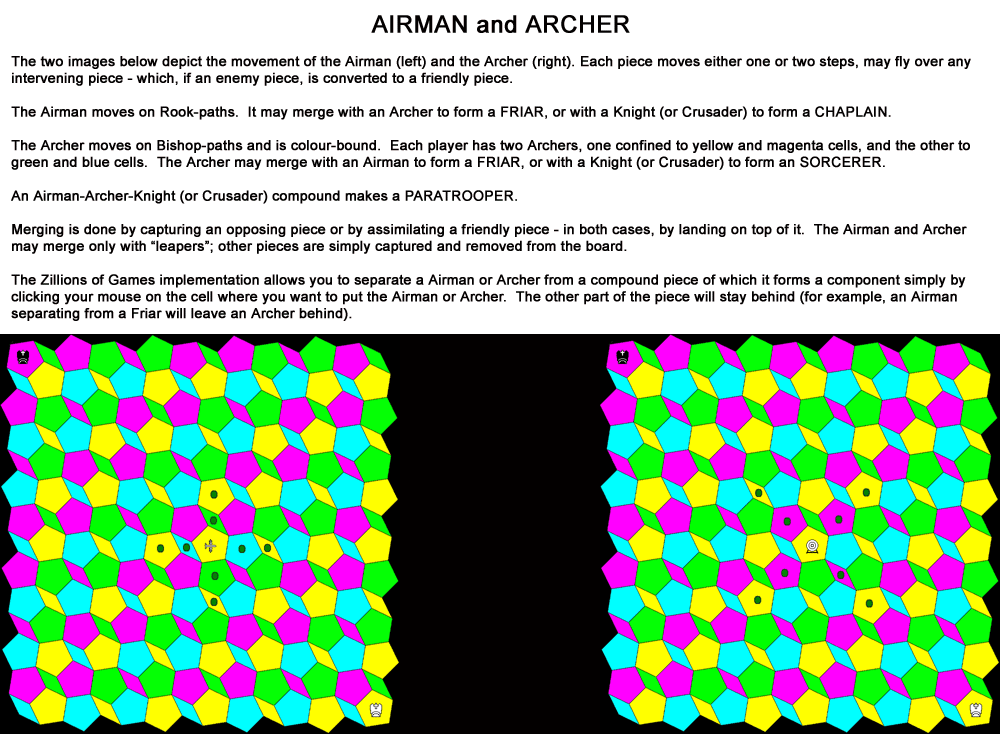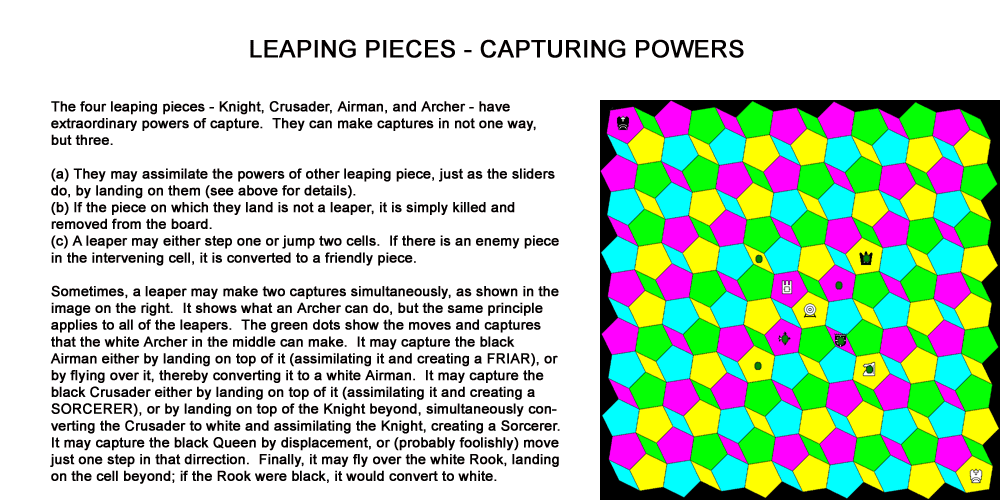Matrix Chess
I first discovered the unique tessallation of pentagons and diamonds sometime in 2003, and thought it would make a great board for a chess-like game. As I knew nothing about Zillions of Games programming at the time, I just jotted down a few basic ideas about piece movements (I thought of the WARLORD at that time), and put the project on the shelf. After learning a little Zillions programming, I returned to the idea in March 2010, incorporating some of my original ideas, along with some borrowed from other variants.There are four ways to capture pieces: displacement (as in FIDE and many other variants), assimilation (absorbing the powers of captured pieces, as well as friendly pieces through "mergers"), conversion, and sandwiching. See the Rules section for details.
Setup

Pieces
The pieces, except for Pawns, Guards, and the King, are grouped together in two "families". Please see the diagrams illustrating how they move.Rules
There are four ways to make captures:
1. Displacement - enemy pieces that are not of the same "family" are simply removed from the board, as in FIDE and most other traditional varieties of Chess.
2. Assimilation - a piece may capture both friends and foes of the same "family" and assimilate their powers. The Rook (a sliding piece) may merge with a Ringmaster (also a slider) to form a Princess. It may not merge with, say, a Knight, because the Knight is not a slider.
Note that compound pieces formed this way may be split apart later. In the Zillions implementation, to break a Princess down into its components, simply click your mouse on the cell where you want the Rook-part or the Ringmaster-part to go. That part will move, leaving the other part behind. Fergus Duniho first popularized this method of capture in some of his games in the early 2000s.
3. Conversion - a leaping piece (Knight, Archer, Airman, Sailor, or any compound thereof) may convert an enemy piece to a friendly piece simply by flying over it and landing on the cell beyond. N.B. If the cell beyond is also occupied by an enemy piece, a leaper may make two captures simultaneously. For example, a Knight flying over an enemy Rook and landing on top of an enemy Spire would convert the former and kill the latter, in one move. An Archer flying over an enemy Ringmaster and landing on top of a Knight (either friend or foe) would simultaneously convert the Ringmaster and assimilate the Knight.
4. Sandwiching - Pawns and Guards also convert enemy pieces to friendly pieces, by "sandwiching." An enemy Knight caught between two friendly Pawns, for example, is converted to a friendly Knight. On rare occasions, Pawns and Guards may be able to capture two pieces simultaneously.
There are three ways to win:
1. Checkmate.
2. Stalemate - I would like to make this better than a draw, but not quite as good as a checkmate. In tournaments, FIDE awards one point for a checkmate and a half-point to each player for a draw, with stalemate counting as a draw. For this game (and any others that I invent), I would award a half-point for a stalemate - but only to the player forcing the stalemate. I cannot implement this in the Zillions programme, as it does not differentiate between superior and inferior wins, so for the Zillions programme, a stalemate is a win.
3. Converson of the King - given that leaping pieces convert enemy pieces by flying over them, and that Pawns and Guards also convert enemy pieces by sandwiching, it is possible for the King to be converted to an enemy piece (this actually happened once while playtesting this game with Zillions). The player whose King defects to the enemy, of course, loses the game.
Notes
Piece valuesZillions of Games estimates that the pieces have the following values on the larger of the two boards:
Guard - 6147 (0.7 pawns); Pawn - 8501; Crusader - 14423 (1.7 pawns); Knight - 20059 (2.4 pawns); Archer - 20062 (2.4 pawns); Monk - 25860 (3.0 pawns); Airman - 26783 (3.2 pawns); Bishop - 48562 (5.7 pawns); Warlord - 51135 (6.0 pawns); Rook - 83304 (9.8 pawns).
For reasons explained above, the published version of Zillions merges the Warlord and Monk into a single piece with a value of 69901 (8.2 pawns). The Knight and Crusader are also merged, with a value of 27932 (3.3 pawns). In practice, that results in a slight distortion: It overvalues the Warlord and Knight (representing the Monk and Crusader) on diamonds, while undervaluing them on pentagons. The fact that there is no way for one of these pieces to move from a diamond to a pentagon or vice versa makes it simpler for programming purposes to merge them, but causes some value distortion. I thought the compromise was worth it, however, as it affects both players equally, thereby avoiding giving any unfair advantage to either player.
The compound pieces are worth slightly more than the sum of their parts. I personally disagree with some of the Zillions estimates but assigning values to pieces is not an exact science; even experts disagree about the relative value of the pieces in FIDE chess, and the value assigned to the Queen by Zillions (7.7 pawns) is less than what most experts estimate.
Despite the inherent subjectivity of Zillions estimates, they are good as a rough guide.
Play Matrix Chess!
 I have programmed a Zillions of Games file to play this game. You may download it here. You need the Zillions of Games engine installed to play it.
I have programmed a Zillions of Games file to play this game. You may download it here. You need the Zillions of Games engine installed to play it.
 This 'user submitted' page is a collaboration between the posting user and the Chess Variant Pages. Registered contributors to the Chess Variant Pages have the ability to post their own works, subject to review and editing by the Chess Variant Pages Editorial Staff.
This 'user submitted' page is a collaboration between the posting user and the Chess Variant Pages. Registered contributors to the Chess Variant Pages have the ability to post their own works, subject to review and editing by the Chess Variant Pages Editorial Staff.
By David Cannon.
Web page created: 2010-06-15. Web page last updated: 2010-06-15






